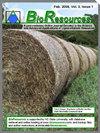Novel poly(β-cyclodextrin) porous material as solid phase extraction sorbent for aniline derivatives in rubber samples
IF 1.6
4区 农林科学
Q2 MATERIALS SCIENCE, PAPER & WOOD
引用次数: 0
Abstract
Aniline derivates are widely used in rubber products as anti-aging agents, but their biological toxicity causes harm in the use and recycling of rubber products. Therefore, in this study, a high-performance poly(3,4,5,6-tetra-fluorophthalonitrile-β-cyclodextrin)(P-TFPN-β-CD) solid-phase extraction (SPE) adsorbent was synthesized and applied to extract and detect aniline derivatives in rubber specimens. After crosslinking with 3,4,5,6-tetrafluorophthalonitrile (TFPN), the polymer exhibited mesopores (7.88 nm) and a large specific area (55.2 m2/g). The porous structure significantly improved the extraction efficiency (recovery was between 90.1% and 110.5%) and rate (60% in 10 s) of 4 aniline derivatives (aniline, N-ethyl aniline, 1,2-phenylenediamine, and p-phenylenediamine). With a combined gas chromatographic-flame ionization detector (GC-FID), the extracted aniline derivatives were accurately detected (RSD = 1.60% to 9.90%). Due to the weak interaction between P-TFPN-β-CD and analyte, the prepared poly-TFPN-β-CD SPE adsorbent was regenerated via mild washing with methanol. The high absorption capacities remained after 4 extracting-washing cycles. The novel porous SPE adsorbent showed good extracting and recycling performance for the analysis and detection of aniline compounds in rubber. Thus, it has good prospects for application to improve detection efficiency and reduce cost.新型聚β-环糊精多孔材料作为橡胶样品中苯胺衍生物的固相萃取吸附剂
苯胺类衍生物作为抗老化剂广泛应用于橡胶制品中,但其生物毒性在橡胶制品的使用和回收中造成危害。因此,本研究合成了一种高性能聚(3,4,5,6-四氟眼腈-β-环糊精)(P-TFPN-β-CD)固相萃取(SPE)吸附剂,并将其应用于橡胶样品中苯胺衍生物的提取和检测。与3,4,5,6-四氟眼腈(TFPN)交联后,聚合物表现出7.88 nm的介孔和55.2 m2/g的大比表面积。该多孔结构显著提高了4种苯胺类衍生物(苯胺、n -乙基苯胺、1,2-苯二胺和对苯二胺)的提取效率(回收率在90.1% ~ 110.5%之间)和提取率(10 s内达到60%)。采用气相色谱-火焰离子化检测器(GC-FID)对提取的苯胺衍生物进行了准确的检测(RSD = 1.60% ~ 9.90%)。由于P-TFPN-β-CD与被分析物的相互作用较弱,制备的聚tfpn -β-CD SPE吸附剂经甲醇温和洗涤再生。经过4次萃取-洗涤循环后,仍保持较高的吸附能力。新型多孔固相萃取吸附剂对橡胶中苯胺类化合物的分析和检测具有良好的萃取和回收性能。因此,在提高检测效率和降低成本方面具有良好的应用前景。
本文章由计算机程序翻译,如有差异,请以英文原文为准。
求助全文
约1分钟内获得全文
求助全文
来源期刊

Bioresources
工程技术-材料科学:纸与木材
CiteScore
2.90
自引率
13.30%
发文量
397
审稿时长
2.3 months
期刊介绍:
The purpose of BioResources is to promote scientific discourse and to foster scientific developments related to sustainable manufacture involving lignocellulosic or woody biomass resources, including wood and agricultural residues. BioResources will focus on advances in science and technology. Emphasis will be placed on bioproducts, bioenergy, papermaking technology, wood products, new manufacturing materials, composite structures, and chemicals derived from lignocellulosic biomass.
 求助内容:
求助内容: 应助结果提醒方式:
应助结果提醒方式:


